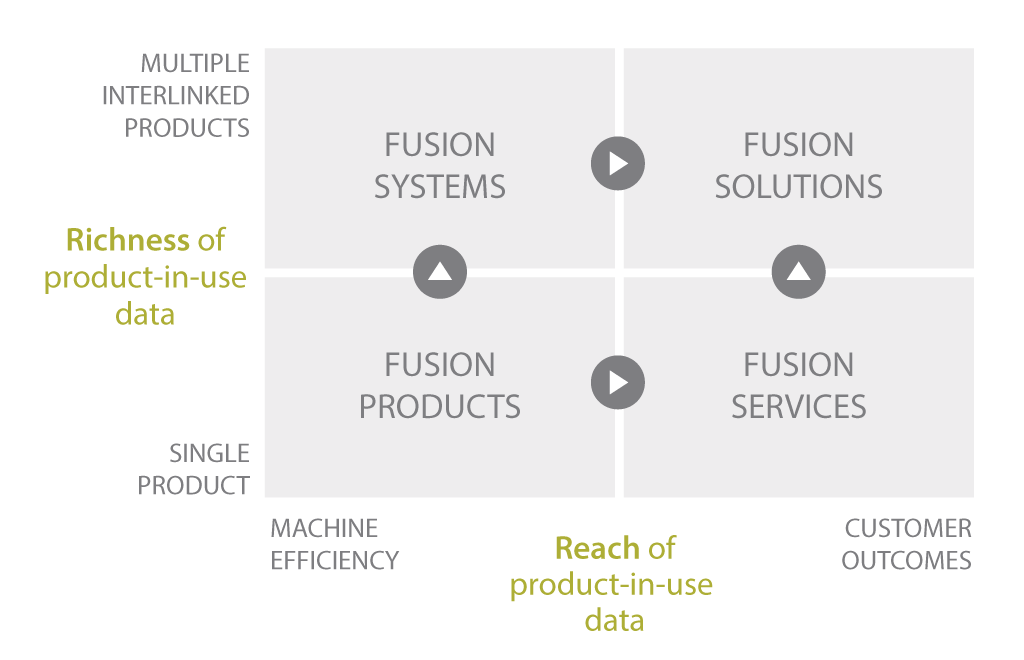Fusion strategy, how industry can make a difference with AI – Harvard Business School
In the recent book Fusion Strategy, world-renowned innovation guru Vijay Govindarajan and digital strategy expert Venkat Venkatraman offer a roadmap that will help industrial companies combine what they do best – creating physical products – with what digital technology companies do best – capturing and analyzing data through algorithms and AI.
Real-time data and AI are defining the industrial future
Technology giants like Facebook, Amazon and Google can collect real-time data from billions of users. For companies that design and manufacture physical products, that kind of fluid, data-rich information used to be a dream. Now, with the rise of cheap and powerful chips, supercomputing and artificial intelligence, things are changing rapidly.
In the future, industrial companies will excel not only by designing and delivering brilliant machines, e.g., but also by ensuring that their machines are equipped with sensors, software and real-time telematics functionality. This makes it possible to improve the productivity of industrial assets and provide new personalized solutions to business challenges.
Ultimately, the combination of AI and real-time data will lead to a new generation of business models that will boost products, strategies and customer relationships. If companies adopt “fusion” strategies, they can create incredible new value. If they don’t, they will be left behind.
Fusion Strategy Framework
Companies need to ask themselves two questions:
- What is the reach of our product-in-use data?
- How rich is our product-in-use data?
Their answers will help them develop four types of fusion strategies: fusion products, fusion services, fusion systems and fusion solutions. The fusion strategy framework is inherently dynamic. Most companies will start with fusion products, which require the least amount of data to build, and then expand to fusion services and systems as they gain more experience. From there, they can move on to fusion solutions, which create the most value.

- Products: the focus on products in the “fusion strategy” includes embedding digital technologies directly into physical products. This includes the use of sensors, IoT devices and smart components that allow products to collect and transmit data in real time. These “intelligent” products are capable of self-monitoring, self-diagnosis and even self-optimization based on the data they generate. This transformation leads to products that are not only more efficient and effective, but also more responsive to customer needs through data-driven insights.
- Systems: systems in Fusion Strategy refers to the complex integration of various digital and physical components that work together to improve industrial operations. This includes everything from manufacturing systems to supply chain logistics. By using technologies such as AI and machine learning, these systems can become more adaptive and responsive. The use of digital twins (virtual replicas of physical systems) allows companies to simulate and optimize processes before they are implemented in the real world, reducing risk and improving outcomes.
- Services: the services component of the “fusion strategy” emphasizes the shift from selling products to offering ongoing services based on those products. These can include maintenance services, software updates and continuous monitoring services that leverage the data generated by connected products. The service strategy is often based on a subscription model, which guarantees stable revenue streams and helps build long-term customer relationships. It also places a strong emphasis on customer service and support, transforming customer interaction from transactional to relational.
- Solutions: solutions in Fusion Strategy is about creating a comprehensive offering that solves specific customer problems through a combination of products, systems and data insights. These solutions are often highly customized to individual customer needs and are developed based on a deep understanding of data gathered from a variety of sources. By focusing on solutions rather than stand-alone products, companies can provide more value and develop closer relationships with their customers, often leading to ongoing service opportunities. If you choose to “unburden” the customer, you will benefit from going full steam ahead with this.
Integrated approach
A key theme in the “fusion strategy” is the integrated approach to all these elements: products, systems, solutions and services. The idea is to create a seamless ecosystem in which each component enhances the others, powered by real-time data and digital technologies. This not only improves internal efficiency, but also increases customer satisfaction by providing more comprehensive, responsive and customizable offerings.
In essence, the Fusion Strategy framework described in the book encourages companies to think holistically about how digital technologies can transform their products, systems, solutions and services. By doing so, they can not only improve their operational efficiency and product offerings, but also revolutionize their business models to better meet the demands of a digital economy.
The laws of competitive advantage are changing, rewarding those with the most robust, data-driven insights rather than the most valuable assets. To compete in the new digital age, companies must use real-time data to boost their products, strategies and customer relationships. Those that fail to do so risk falling on the wrong side of the next great digital divide.

Does your company need an AI Strategy & Roadmap?
Then engage Lemento as a partner and facilitator to guide this process.
Our AI Strategy & Roadmap Workshop is designed to equip your management team with the right knowledge and tools. Identify your biggest AI opportunities, develop your AI strategy and implementation plan and get started.


